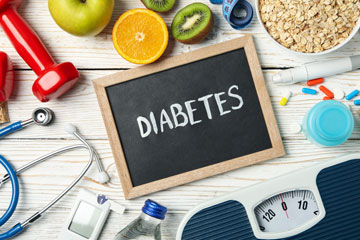Diabetes is a chronic disease that causes higher than normal blood sugar levels. Excess sugar in the blood can cause serious complications such as kidney failure, heart attacks, stroke, amputations and blindness, and is linked to an increased risk for several cancers. A person with diabetes must follow an active lifestyle and a healthy diet to control blood sugar levels. You need to pay attention to your food choices, importantly, the carbohydrates you eat. Consuming carbs can increase your blood sugar levels. You need to choose items from all food groups and create a diet plan that includes foods low in sugar and carbohydrates, healthy fats, fiber, and protein. You should know what and how much you can eat when you plan your diet.
Smart Eating for Diabetes: 11 Foods to Include in Your Diet
Let’s take a look at the best foods to include in your diet to control diabetes:
- Eggs: Eggs are a low-carb food and have a very low glycemic index score, which makes them a good source of protein for people with diabetes (www.medicalnewstoday.com). Protein takes time to digest and eating eggs give you a satiated feeling. A 2018 study suggests that eating eggs regularly could improve fasting blood glucose in people with prediabetes or type 2 diabetes.
- Beans: An excellent food option for people with diabetes, beans are a plant-based protein that ranks very low in the glycemic index (GI) scale. They can help regulate blood sugar levels. The carbs content in beans is complex and the body digests them slower than it does other carbohydrates. Beans also contains important nutrients such as iron, potassium, and magnesium. There are a wide variety of beans such as kidney beans, black beans, navy beans, etc. When you buy canned beans, make sure you choose one without added salt.
- Fatty fish: Salmon, sardines, mackerel, etc. are good sources of the omega-3 fatty acids DHA and EPA, which greatly benefit heart health. Getting the right amount of these fats regularly is crucial for people with diabetes who have an increased risk of heart disease and stroke. DHA and EPA protect the cells that line the blood vessels, reduce markers of inflammation, and help improve artery function. They are also rich in protein and helps stabilize blood sugar levels.
- Leafy greens: These are low in calories and packed with essential vitamins, nutrients, and minerals. They are low in carbs absorbed by the body and have a low impact on blood sugar levels. Spinach and kale are sources of vitamin A and calcium, and also provide fiber and protein. Leafy greens are also a good source of antioxidants lutein and zeaxanthin that protect the eyes from common diabetic complications like macular degeneration and cataracts. Diabetics should include green leafy vegetables like spinach, kale, cabbage, broccoli, and bok choy in their diet.
- Avocados: Avocados are low in carbohydrates, and have less than 1 gram of sugar, high fiber content, and healthy fats. Eating avocado can can keep blood sugar level from rising, improves overall diet quality, and significantly lowers body weight and body mass index. It can help reduce the risk of heart disease.
- Chia Seeds: Due to the high antioxidant and omega-3 content, people often call chia seeds a superfood. This a good source of plant-based protein and fiber and low in digestible carbs. The viscous fiber in chia seeds can lower blood sugar levels by slowing down the rate at which food moves through the gut and absorbed. The fiber content in chia seeds makes you feel full and reduces hunger which can help you achieve a healthy weight.
- Nuts: Cashews, almonds, Brazil nuts, hazelnuts, walnuts, etc., contains fiber and are low in net carbs. Nuts help people with diabetes improve heart health. Research shows that regular consumption of nuts may reduce inflammation and blood sugar levels, and also lower LDL cholesterol levels.
- Garlic: Garlic has low-calorie count and is exteremly nutritious. One clove, which is 3 grams of garlic, contains manganese, vitamin C and B6, selenium, and fiber. Research shows that garlic contributes to improved blood glucose management and can help regulate cholesterol. In people with diabetes, it helps lower blood sugar, inflammation, LDL cholesterol, and blood pressure.
- Broccoli: The non-starchy vegetable is included in every superfood list. It is a low-calorie, low carb food with high nutrient value. Studies show that eating broccoli sprouts may help lower insulin levels and protect against cellular damage. It is also a good source of vitamin C and contains antioxidants lutein and zeaxanthin that helps prevent eye diseases.
- Sweet potatoes: As they have less GI than white potatoes, diabetes patients can use it as an alternative to white potatoes. They will release sugar more slowly and do not raise blood sugar as much. They are also rich in fiber, Vitamin A & C, and potassium. You can have them baked, roasted, boiled, or mashed. For a balanced meal, eat them along with a source of lean protein and green leafy vegetables or a salad.
- Citrus fruits: Citrus fruits are a great source of vitamin C, folate, and potassium. Studies have shown that citrus fruits like oranges, grapefruits, and lemons, have antidiabetic effects. These fruits are a good option to get vitamins and minerals without the carbs.
Also read: Can Fruit Be a Part of the Diabetes Diet?
When planning their diet, people with diabetes are advised to limit or balance:
- Foods that are heavy in carbs
- Foods that are heavy in salt
- Fruits that are high in GI
- Unhealthful fats like saturated fats and trans fats
- Sugary drinks
- Refined sugar
Plan your diet by including these foods and ensure that you eat the right amount. This will help keep your blood sugar in the target range, manage your weight, and reduce risk of complications from diabetes.

